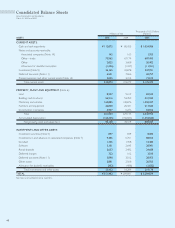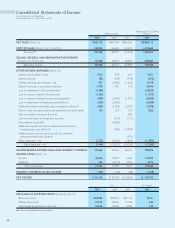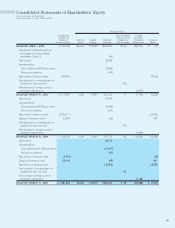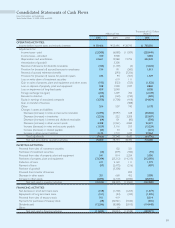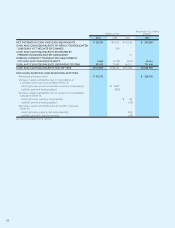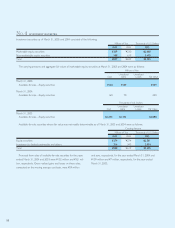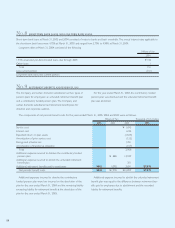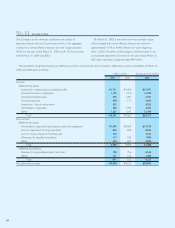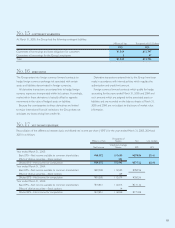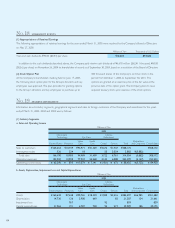Pentax 2005 Annual Report Download - page 57
Download and view the complete annual report
Please find page 57 of the 2005 Pentax annual report below. You can navigate through the pages in the report by either clicking on the pages listed below, or by using the keyword search tool below to find specific information within the annual report.
54
f. Long-Lived Assets—In August 2002, the Business Accounting
Council issued a Statement of Opinion, “Accounting for Impairment
of Fixed Assets,” and in October 2003 the Accounting Standards
Board of Japan (“ASB”) issued ASB Guidance No. 6, “Guidance
for Accounting Standard for Impairment of Fixed Assets.” These
new pronouncements are effective for fiscal years beginning on or
after April 1, 2005 with early adoption permitted for fiscal years
ending on or after March 31, 2004.
The Group adopted the new accounting standard for impair-
ment of fixed assets for the year ended March 31, 2004.
The Group reviews its long-lived assets for impairment when-
ever events or changes in circumstance indicate the carrying amount
of an asset or asset group may not be recoverable. An impairment
loss would be recognized if the carrying amount of an asset or
asset group exceeds the sum of the undiscounted future cash
flows expected to result from the continued use and eventual dis-
position of the asset or asset group. The impairment loss would
be measured as the amount by which the carrying amount of the
asset exceeds its recoverable amount, which is the higher of the
discounted cash flows from the continued use and eventual
disposition of the asset or the net selling price at disposition.
The effect of adoption of the new accounting standard for
impairment of fixed assets was to decrease income before income
taxes and minority interests for the years ended March 31, 2005
and 2004 by ¥859 million ($8,028 thousand) and ¥2,040 million,
respectively.
g. Intangible Assets—Intangible assets are carried at cost less
accumulated amortization, which is calculated by the straight-line
method. Amortization of software is calculated by the straight-line
method over 5 years. Goodwill recognized under the Japanese
Commercial Code (the “Code”) is fully charged to income when
incurred.
h. Retirement Benefits—The Company and certain subsidiaries
had a contributory funded pension plan and an unfunded retire-
ment benefit plan which covered substantially all of their employees.
Effective April 1, 2000, the Company and domestic subsidiaries
adopted a new accounting standard for employees’ retirement
benefits and accounted for the liability for retirement benefits
based on projected benefit obligations and plan assets at the
balance sheet date. The transitional obligation of ¥3,166 million,
determined as of April 1, 2000, was being amortized over 15
years and presented as other expense in the consolidated
statements of income.
For the year ended March 31, 2003, the contributory funded
pension plan was dissolved and the unfunded retirement benefit
plan was abolished. The remaining balance of transitional obliga-
tion at the dissolution of the contributory funded pension plan
and the abolishment of the unfunded retirement benefit plan was
charged to income.
The annual provision for accrued retirement benefits for direc-
tors and corporate auditors of the Company and its domestic
subsidiaries was also calculated to state the liability at the amount
that would be required if all directors and corporate auditors
retired at each balance sheet date. The provisions for the
retirement benefits are not funded.
For the year ended March 31, 2004, the Company and its
domestic subsidiaries abolished the retirement benefit plan for
directors and corporate auditors.
i. Research and Development Expenses—Research and develop-
ment expenses are charged to income when incurred.
j. Leases—All leases are accounted for as operating leases. Under
Japanese accounting standards for leases, finance leases that deem
to transfer ownership of the leased property to the lessee are
to be capitalized, while other finance leases are permitted to be
accounted for as operating lease transactions if certain “as if
capitalized” information is disclosed in the notes to the lessee’s
consolidated financial statements.
k. Income Taxes—The provision for income taxes is computed
based on the pretax income included in the consolidated state-
ments of income. The asset and liability approach is used to rec-
ognize deferred tax assets and liabilities for the expected future
tax consequences of temporary differences between the carrying
amounts and the tax bases of assets and liabilities. Deferred taxes
are measured by applying currently enacted tax laws to the
temporary differences.
l. Appropriations of Retained Earnings—Appropriations of
retained earnings at each year end are reflected in the consoli-
dated financial statements for the following year upon shareholders’
approval or resolution of the Board of Directors.
m. Foreign Currency Transactions—All short-term and long-
term monetary receivables and payables denominated in foreign
currencies are translated into Japanese yen at the exchange rates
at the balance sheet date. The foreign exchange gains and losses
from translation are recognized in the statements of income to
the extent that they are not hedged by forward exchange contracts.
n. Foreign Currency Financial Statements—The balance sheet
accounts of the consolidated overseas subsidiaries and associated
companies are translated into Japanese yen at the current
exchange rates as of the balance sheet dates except for share-
holders’ equity, which is translated at historical exchange rates.




